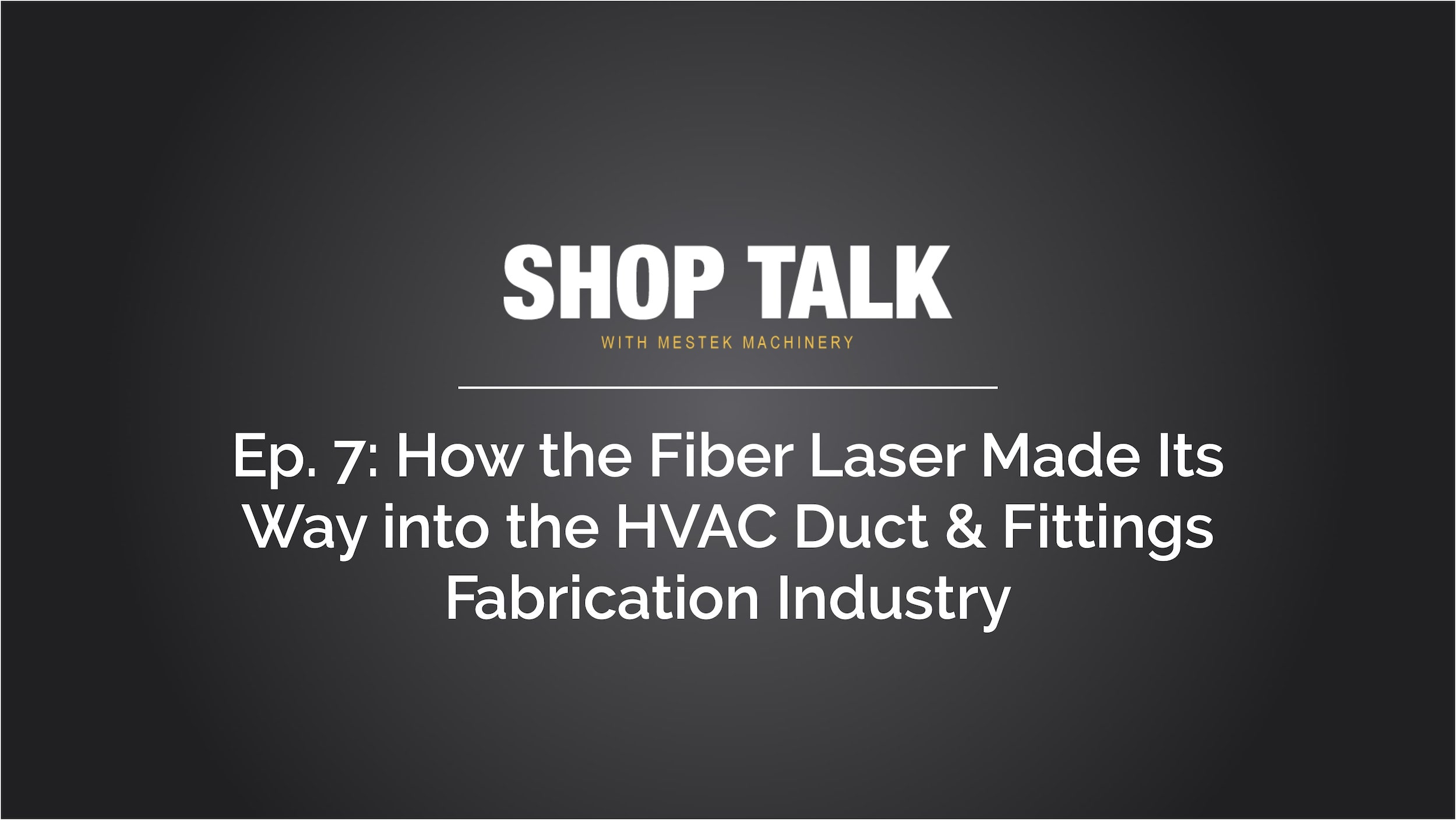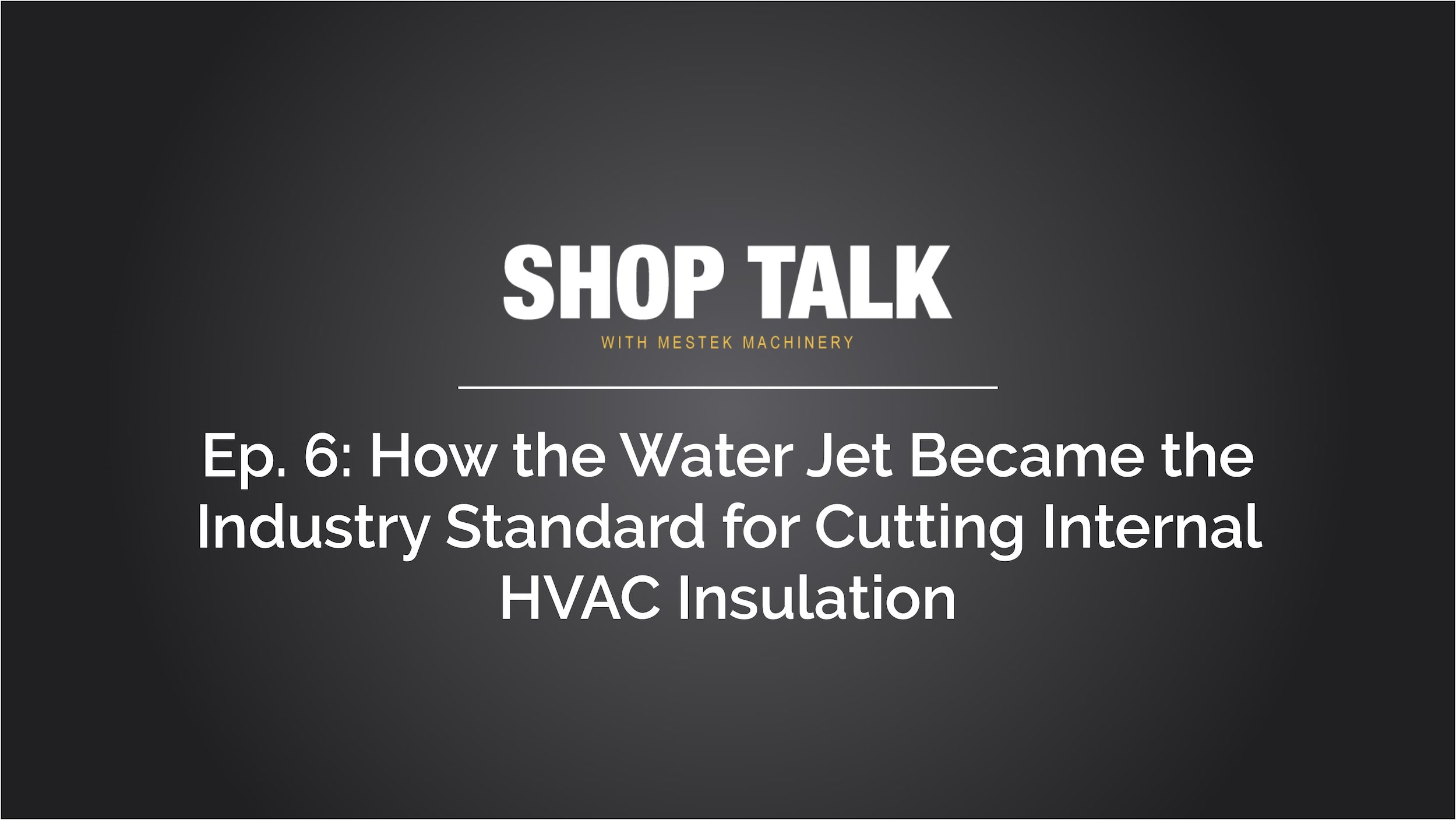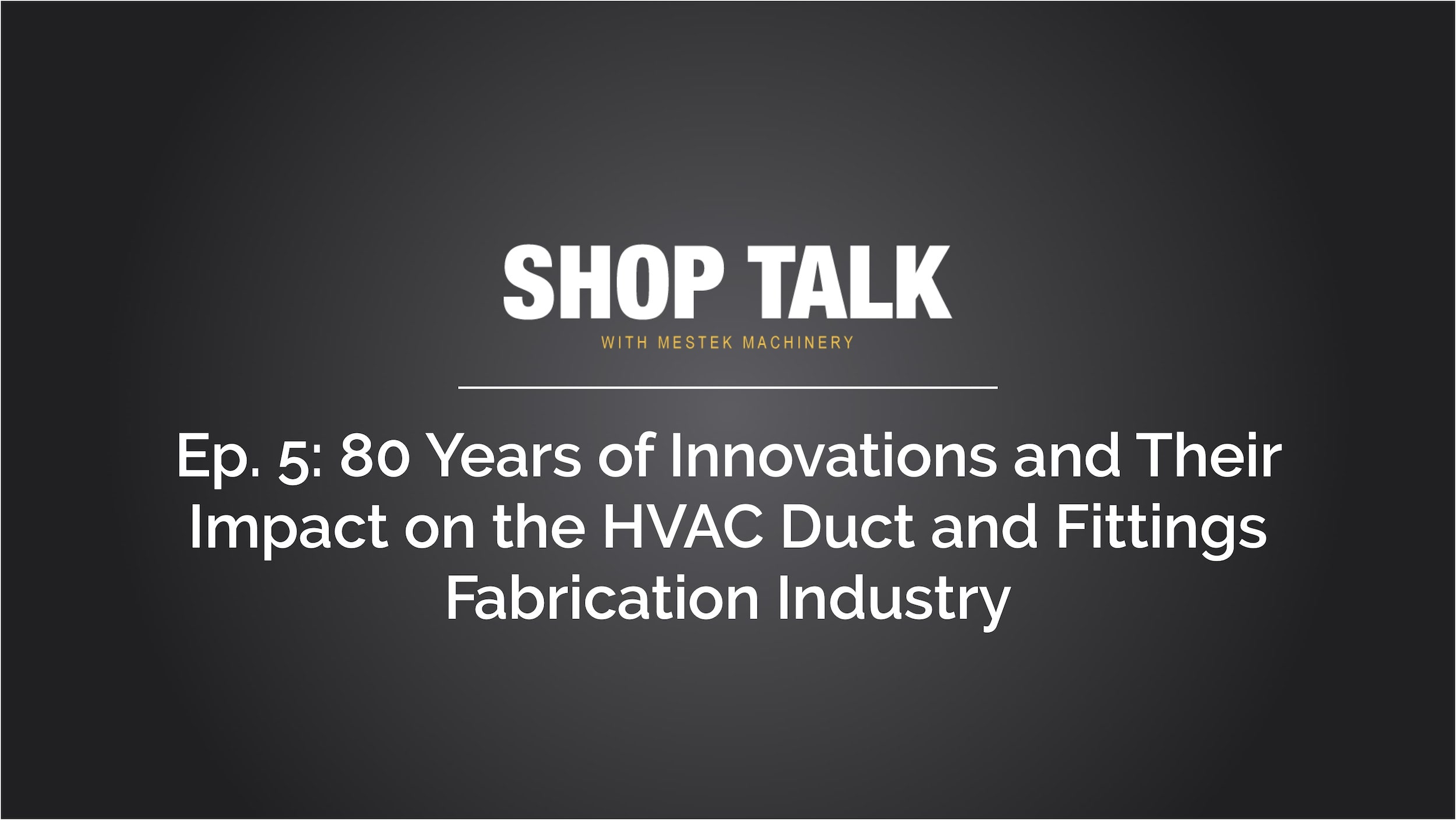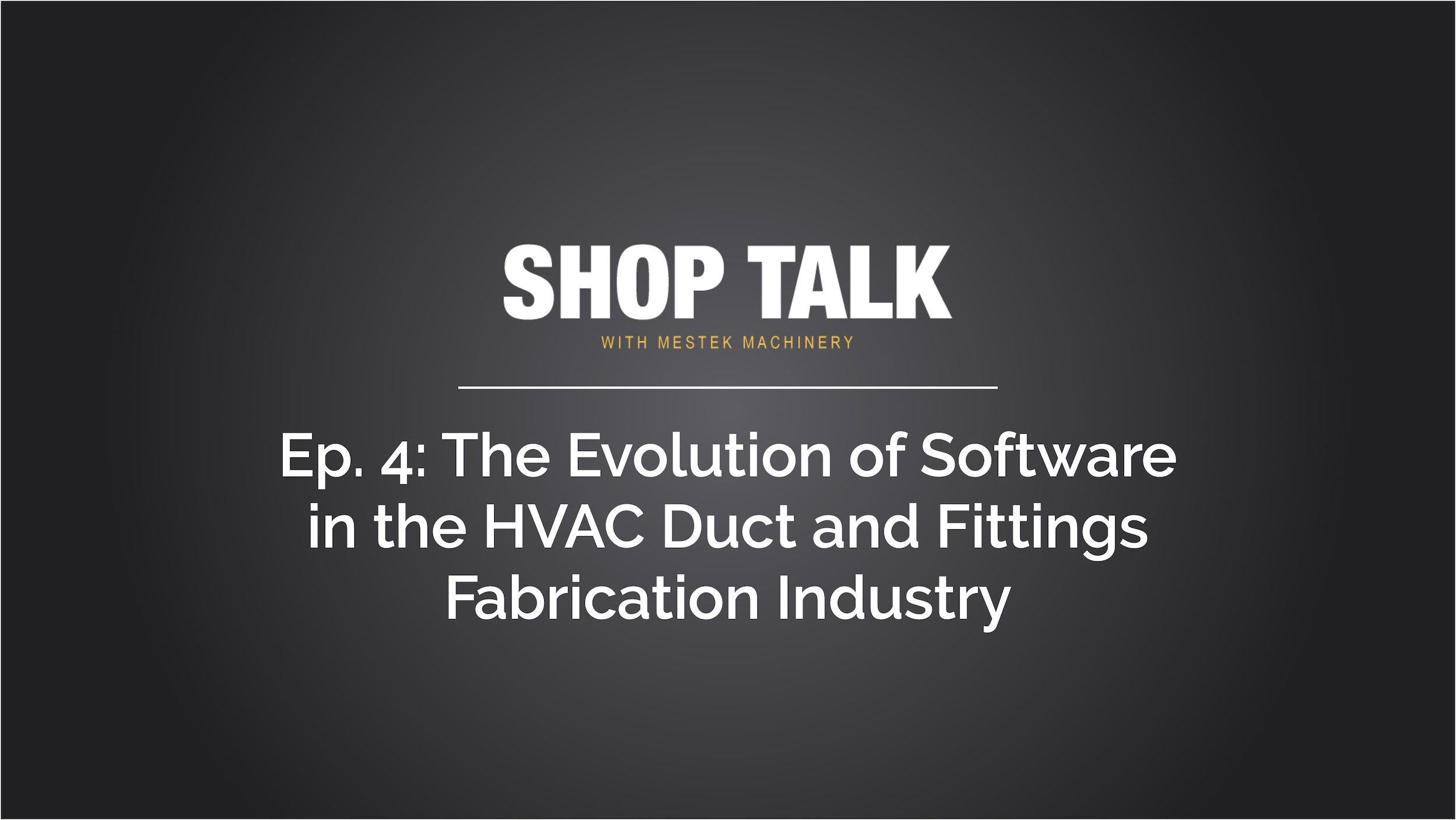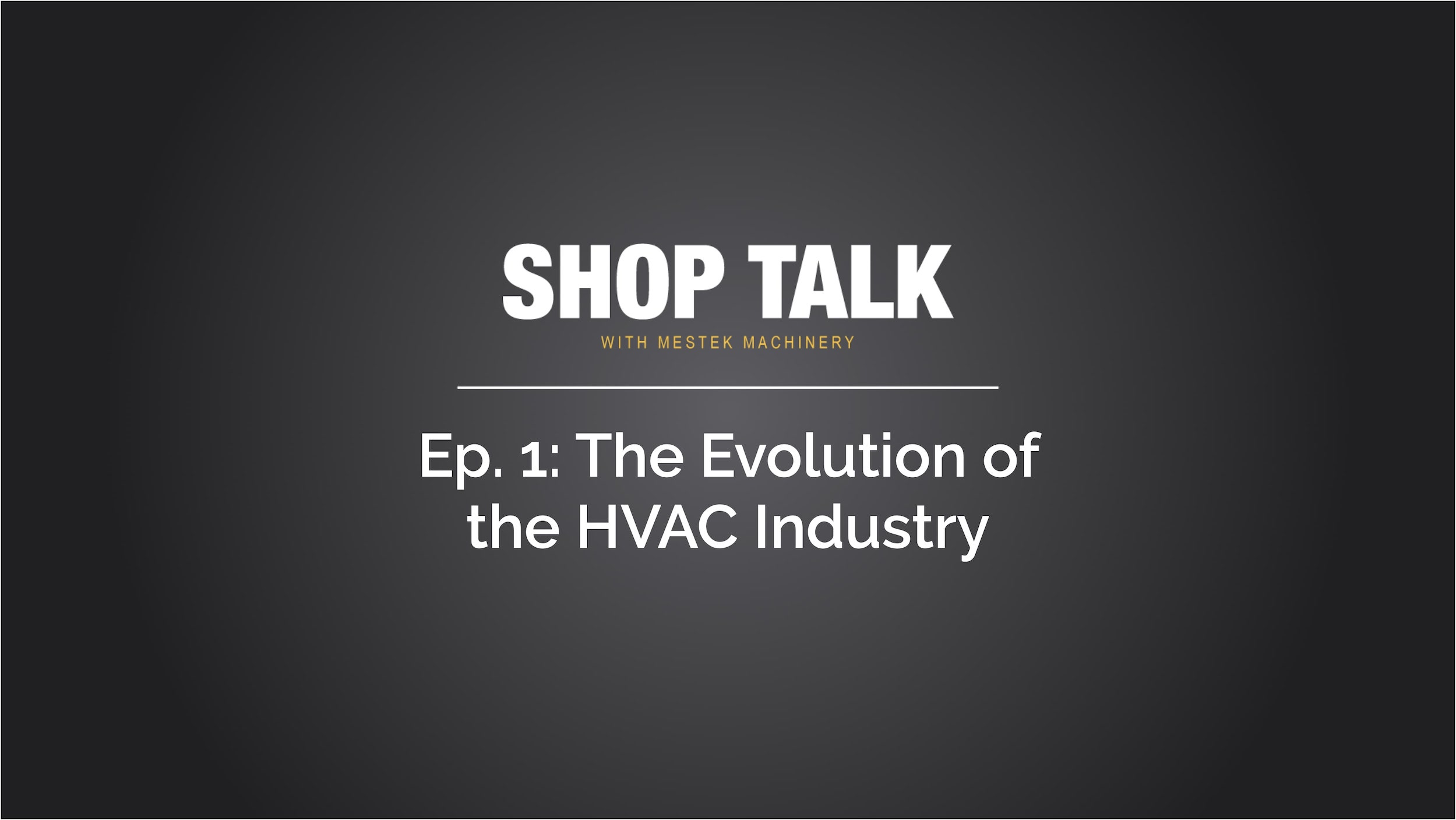Shop Talk with Mestek Machinery is a new video and podcast series developed as way to to discuss the topics that matter most to the HVAC duct and fittings fabrication industry and to provide another good resource to fabrication shops or contractors (or anyone else in the industry) as you look for ways to improve your operations. In this podcast, John Welty is joined by Mike Bailey and David Daw and our discussion focuses on one of the latest operational trends in the industry: Pre-Fabrication (or Pre-Fab). Of course, pre-fabrication is quite a broad topic and this conversation really looks at pre-fab from more of an overview perspective. As you’ll see from the discussion, there’s a lot different parts of the industry that are affected by pre-fab and we’re going to continue to talk about the different facets of pre-fab in future Shop Talks. If you’re already doing pre-fab or are thinking about getting into it, please know that we’re here to help. Please don’t hesitate to reach out for a consultation — we’d love to understand what you’re looking to do and see how we can help you achieve your objectives (and there’s absolutely no obligation).
Meet the Panelists

John Welty
Owner | Welty Automation
- Welty Automation is a strategic partner providing machine automation and engineering support to Mestek Machinery
-
Started at Iowa Precision Industries in 1996 on the drafting board
-
Software development progressed within engineering, and then the factory, and now the HVAC Ductline controls
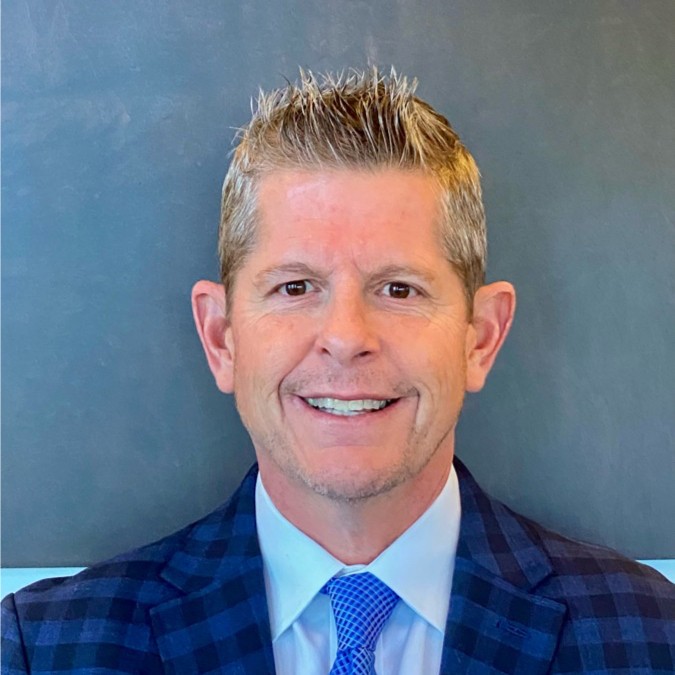
Mike Bailey
Senior VP of Sales | Mestek Machinery
- 27 years in the HVAC duct and fittings fabrication and sheet metal fabrication industries
- Bachelor of Science Degree | James Madison University
- Helped develop Premier Partner Program with SMACNA
- Partner to Trimble and Applied Software Cad to Cam Processes

David Daw
President | HVAC Inventors Systemation, Inc.
- Product Development consultant to Mestek Machinery
- HVAC fabrication industry technology inventor for over 50 years
- Inventor of Cornermatic corner inserter machines, specialized TDC and TDF corners, and Bendermatic (expected to hit the market in mid-2022)
Watch the Video
Listen to the Podcast
Read the Transcript
Hello everyone. I’m John Welty, and welcome to Shop Talk with Mestek Machinery. These shop talks as we’re calling them, are a new video and podcast concept we’re putting together simply as a way to discuss the topics that matter most to the HVAC duct and fittings fabrication industry. We’re really excited about these, as we think they can become a good resource to the industry. Whether you’re a fabrication shop or a contractor, as you look for ways to improve your operations, and this is quite a broad topic, and today our conversation really looks at prefab from more of an overview perspective, but we’re going to make it a point to continue to talk about the different facets of prefab in future Shop Talks. Thanks again for joining us.
Welcome. I’m John Welty, and welcome to Shop Talks with Mestek Machinery. I’m here with David Daw and Mike Bailey, guys with a lot of experience in the industry. And we’re going to be talking about prefabrication today. So I’ve been out on some installs that I’ve noticed something going on where after they’re producing the rectangular duct through a duct line, I’m seeing them put the duct together, bolt it all together, flange it together, blue plastic on the ends, but they’re doing like 50 foot sections, and then they load it right on semi trailers backed right up to the building.
And my first thought… I don’t have a lot of experience with what they’re doing with that was, that’s going to be a lot of handling. Right?
Yeah.
And so, I was kind of curious about what’s going on with that. What do you guys see happening with that type of stuff?
Yeah. I first noticed the trend I’ll call it, the prefabrication, in California about six or seven years ago. And like you, I saw this and I’m like, “What is going on here?” Because there was not only duct being sectioned together, there was conicals and taps and collars that were installed, and they were sealed, and… Yeah, and I’m just kind of watching this process going “Well, that’s supposed to be happening in the field.”
Yeah.
But then, as I started asking around and traveling around the country and started seeing more and more of it, it’s become… The hot buzzword in the industry is prefabrication. I can only lend some of the contractors’ views of that as why it’s become standard, really. They’ve always done it the the wet side, is what I’ve been told. It’s just now started to really take effect on the dry side, which would be our side, but it is more handling, but there’s less inventory to keep up with in the field, because you section them all together.
So it’s one piece versus multiples. You also talk to some contractors, they feel like that their shop labor is more tenured in the shop than in the field, because the field labor tends to move around a little bit more. But it’s just a better deliverable and a controlled atmosphere. I think that’s the big part that I’ve kind of taken to be the real main reason that prefabrication has become a very real trend when it comes to the dry side of the business.
Well, if you think about this, if you’re shipping each piece of duct work, whether it’s a five foot section or fittings, up until recently those are all individually, either sometimes put in cardboard boxes or thrown onto a truck. So my experience, and what I’ve been told is a rule of thumb is that the field labor was three times shop labor. So you’re paying a dollar an hour in the shop, it’s costing you three dollars in the field, give or take here. So when you’ve got this material, the duct work onto the job site, there’s a whole logistics involved.
Usually, [inaudible 00:03:36] early in the morning. You know, 5:30 to six so they can get them on the job site before the rest of the crews come in. And then, you’ve got an inventory situation where you have all these parts that come off the truck or in a box. However, they… They try to get them floor by floor, say in a high rise, or in a zone in a building. But if all these pieces are separate, running around trying to find the elbow that goes in the straight joint, et cetera, a lot of labor.
Yeah.
So the more you can assemble in your plant under controlled environment, the much less there is of trying to find these pieces and assemble them. It’s so much faster. You put a joint… Particularly in cold weather.
Mm-hmm (affirmative).
If you’re trying to assemble duct work on a day like today here at Akron, it’s cold and windy, and you’re on an exposed building. So if you get a third of that duct work done in the shop, it just eliminates how much field connection time.
So that becomes just a member of the building that’s being put in with the crane then at that point. Is that-
Right.
That’s how it’s working?
Yeah. If you see them on the job site, where they used to haul cages up with loose pieces. Now, they’ve got a couple cables on 50 foot sections, just lifting it right up into place.
Your beam. Yeah.
[inaudible 00:04:50] is the new one. That’s… Usually, riser duct can be 16 gauge black welded duct, and I had a contractor to tell me that he starts sectioning his welded duct together in 40 foot sections with lifting lugs, because he could get the crane out at 7:30 in the morning. He could take a 40 foot riser duct and get it inside the riser with one laborer, not four or five. So he was not only saving time because he could do that within a half a day, where it took him all day with four guys in a chase. So it was not only a time saver, but it was also a safety factor as well.
So then you also… You brought up a better product, so that they’re being in that controlled environment of the factory, they can control the floor being flat, being level, the space that they’re assembling in being… So they can control how the fittings are bolted together, how well they’re sealed-
Yeah.
They can probably do seal checks right there in the factory.
Mm-hmm (affirmative). They are doing that. They’re testing ducts before they go-
Okay.
To fail a leakage test in the field is quite expensive.
Okay.
So that also [crosstalk 00:05:57]
Because you have all that in logistics, and then you got to do it over again.
Yeah.
Yeah yeah.
I think that leads to the prefabrication side as well. Now, if you look back at it, some contractors would tell you that we’re taking 40% of the labor out of the field.
Really?
40%, up to, and you’re saving material by ordering material in volume as well. So there’s so many tentacles to prefabrication and all of this makes sense to me. Now, that culture starts its top. It’s not accepted by all. There’s been several companies that the project managers fought it, or the general contractors said, “You can’t do it.”
Right.
But those two processes got vetted out per se, and then the project managers started to see the value of it, and then away we go, right? So I don’t think it’s… As far as you look at the major metropolitans and major cities, I don’t think it’s caught on in every city to the magnitude it has in some. I’ll tell you this. Atlantans are starting to do it, and the first job’s being done right now, the children’s hospital, and general contractor did say, “You can’t do it. There’s no way.” And they did it.
Yeah.
So that’ll probably be a trend now.
What are the reasons why a GC would not want-
Style of duct work, buildings. You know, you look at New York, you don’t have a lot of land, right? New York is straight up. Atlanta, you’ve got a little bit more land. So every job’s got its own persona. Right? So it just depends on the building.
Well, I suppose those general contractors have their own culture and way of doing things too. So it requires a change for them.
Mm-hmm (affirmative).
So I imagine… We’ve talked before about how changes in technology have happened. There must be quite a bit of tooling around these general contractors and the engineers and the installers working together, because there has to be a lot of collaboration of the right information to the right place at the right time, in order to prefabricate, because I assume while you’re installing, there’s things that perhaps didn’t line up quite the way somebody expected, and changes have to be made. And the more you prefabricate, the more you have to control those variables. Right?
Yeah. I think what you’re speaking on there is the BIM model.
Okay.
Right? Collaboration as far as trades not colliding, right? Together. So now, within the [inaudible 00:08:04] style of software shop detail drawings, that the piping guys can be drawing at the same time as the duct guys and the electrical guys, so you don’t have that collision. The collision checking is a big deal when it comes to prefab, because if the drawings aren’t right, and the buildings aren’t correct, then prefab’s not going to fit. So software’s been a huge part.
And Mike, when you talk about BIM, it is building information management?
Modeling.
Modeling. Building information modeling.
Yeah. And that is a big deal. And I think that’s affording the contractors to be able to even try this prefab.
Yeah. So that’s basically some kind of a common protocol for them to be able to model things together and then assemble their drawings together from different sources, I believe.
Correct.
Yeah.
And they’ll take those drawings into the shop now, versus taking the drawings into the field and trying to put these ducts together, and it kind of… And the spin ends or the air tights or the conicals, or the… Could be fire damaged, whatever it is. Let’s take a welded duct. They have to test that welded duct with that red ink or red dye. And they’re doing that in the shops now before it hits the job site.
Yeah.
And the other part about that with prefab is the fast pace today. These contractors are awarded the job on Friday, and the roof is already on the building Monday. Right? So it’s a matter of just in time inventory a little bit too, but the fast pace in which these jobs are being asked as far as schedules, lends itself to some of the prefab and trying to lessen that human element in the field and reduce that labor in the field, from a time aspect.
Well, I know from being out on installs of just duct [inaudible 00:09:39] that having to fix something in the field at a customer’s factory from our perspective, would be 10 times faster to fix it back in the factory before it ships, and those are the things that we find value taken back to engineering.
Mm-hmm (affirmative).
So I can see how that same type of system applies itself to prefabrication of duct in the field.
Yeah.
For the people that are using those [inaudible 00:10:06] duct lines, because that… In the factory, you’ve got the crane, you’ve got everything you need to solve the problem. You’ve got all the people that are there, the engineers who are there. Whatever you need is there. In the field, you don’t have all of that. So you don’t want to have to be doing all that in the field, and you don’t want the people in the field having to make all these decisions, and then be able to come back and update the information. So that makes a lot of sense.
Mm-hmm (affirmative).
Interesting.
One small part, when you think about the growth of the four bolt connected system, the flange duct, whether it’s slide on or rolled on, every piece of duct work today puts a gasket between the flanges, and most of it’s butyl gasket today. Well, again, I go back out to 30 degree day. That butyl gasket is really not pliable. So just getting it on… Metal’s cold, et cetera, and trying to get it positioned properly, so… And it’s critical for leakage. A lot easier to do that in a shop. Much easier.
Well, doing it in the cold probably has a negative effect on that leakage.
Yeah.
Yeah yeah.
So doing it in the shop is much more controlled, easier to put on, get on the duct properly. So-
There’s a lot to think about.
And I think… We did a podcast not too far ago, talking about the evolution of the industry, and I think this leads right into it, as to how the job sites are run today, and how this prefab is being more widely accepted by not just the contractors, but general contractors and building owners too. You know?
Mm-hmm (affirmative).
Mm-hmm (affirmative).
So I think it’s important to talk about, and I think today, if you went around the country and you talked to contractors, what’s this… What’s your goal? What are you trying to achieve today? Well first, they’re going to tell us, “We’re trying to achieve more production with less human input,” right? The labor pool isn’t what it used to be. But we’re also trying to build more products within our shop, test more products within our shop, so we can make a better deliverable for the field.
So then, my man hours in the field… Installation hours are less, but we’re still doing sizeable jobs. I’ve seen contractors go from 50 million to 100 million, but they haven’t added any labor because of the technology.
Mike, do you see general contractors or even building owners that are in the know on how much savings there are in manifolding or preassemble, would actually write that into the contract, that the sheet metal contract would have to manifold or prefab?
I don’t know a firm answer of that, but I will say most contractors are bidding the jobs as if they were still going install in the field.
Yeah.
So the contractors themselves, they have a little leg room there to-
To pick up some money.
To pick up some… If things go right, of course.
So this might be a topic for another talk, but where do we see… How do we see people keeping up with all the technology changes, with trading their workforce and keeping people up to date on just the changes that are taking place, to how things are being installed, what things need to be paid attention to, how weather affects gaskets and fittings, and that sort of stuff? How do you see people addressing that these days? Do you get into that much?
As far as the products themselves, you mean?
Just in the industry.
Or training in [crosstalk 00:13:15]
Yeah.
There is a big push-
Well, SMACNA is training in combination with the SMWIA. The schools around are probably the only place today that you can get that kind of training.
Yeah. There’s a really big push to try to figure out how are we going to get the younger generation into our industry.
Okay.
So much so, we did through SMACNA, and two contractors on the West Coast did heavy metal camps.
Okay.
Which were widely acceptable.
I remember seen something about that.
Yeah. In Seattle and in San Francisco.
Okay.
It was pretty neat to see how these young kids, and were talking about middle school up through 17 year old kids, who weren’t going to college. They just weren’t college… It wasn’t their thing.
Yeah.
It’s not for everybody.
Right.
And they found a trade that they didn’t know about. And they went to these camps, and I think they had somewhere between 16 and 20, and they were able to obtain three or four. But it was really heartwarming to see the parents talk about this, that their children or their kids were probably not going to go to college. One, maybe they couldn’t afford it. Or two, they just weren’t cut out to be college type kids.
Yeah.
And they found this trade through these camps, and now they have a job, and they have a career to look forward to.
Yeah.
So that’s been a big discussion point for a long time now is, how do we get the younger generation into the trade? And from my perspective, it’s software.
Yeah.
And I think you got to start somewhere in that middle school area, because most of the kids today… And I say kids. Younger generation don’t know how much software drives this business.
Right.
And it absolutely drives this business. So-
Yeah.
That’s a key point.
It’s amazing, more kids… Kids. Do you say kids?
Young generation.
Young generation, if they knew the kind of dollars per hour that they could make in this trade, I think the doors would be… They’d be knocking doors down, because there’s no other… I don’t think there’s any other building trade… There isn’t any building trade that has the highest per hour content than HVAC, and there’s money… If a kid doesn’t want to go to college, he can make a damn good living
And we were going to do the heavy metal thing, because did it… It’s been accomplished in Seattle. It’s been accomplished in San Francisco, and it was widely acceptable and successful. So the next one is just going to be in Atlanta.
Okay.
Where I live, and I’m going to be working with a local contractor to do that. So we’re meeting next week to start to frame that up.
Okay. Good.
Right?
So that’s a program that’s expanding.
Mm-hmm (affirmative).
Well, that’s good to see.
Mm-hmm (affirmative). And then, we talked about, or Dave talked about the JETC centers. Getting out there through the SMACNA community, find out where these training centers are. And for a company like us to try to work hand in hand with these JETC centers to train the younger generation is a big deal too. There’s a lot of about there.
Well, we’ll have to make sure that we have information available below-
Mm-hmm (affirmative).
To follow up on that training center program.
Mm-hmm (affirmative). Sure. Yeah, we will.
All right. Great. Well, I think that’s quite a bit to talk about with the prefabrication. Wraps that up for today. So thank you, Mike.
Yeah.
Thank you, David. And thank you for listening.



